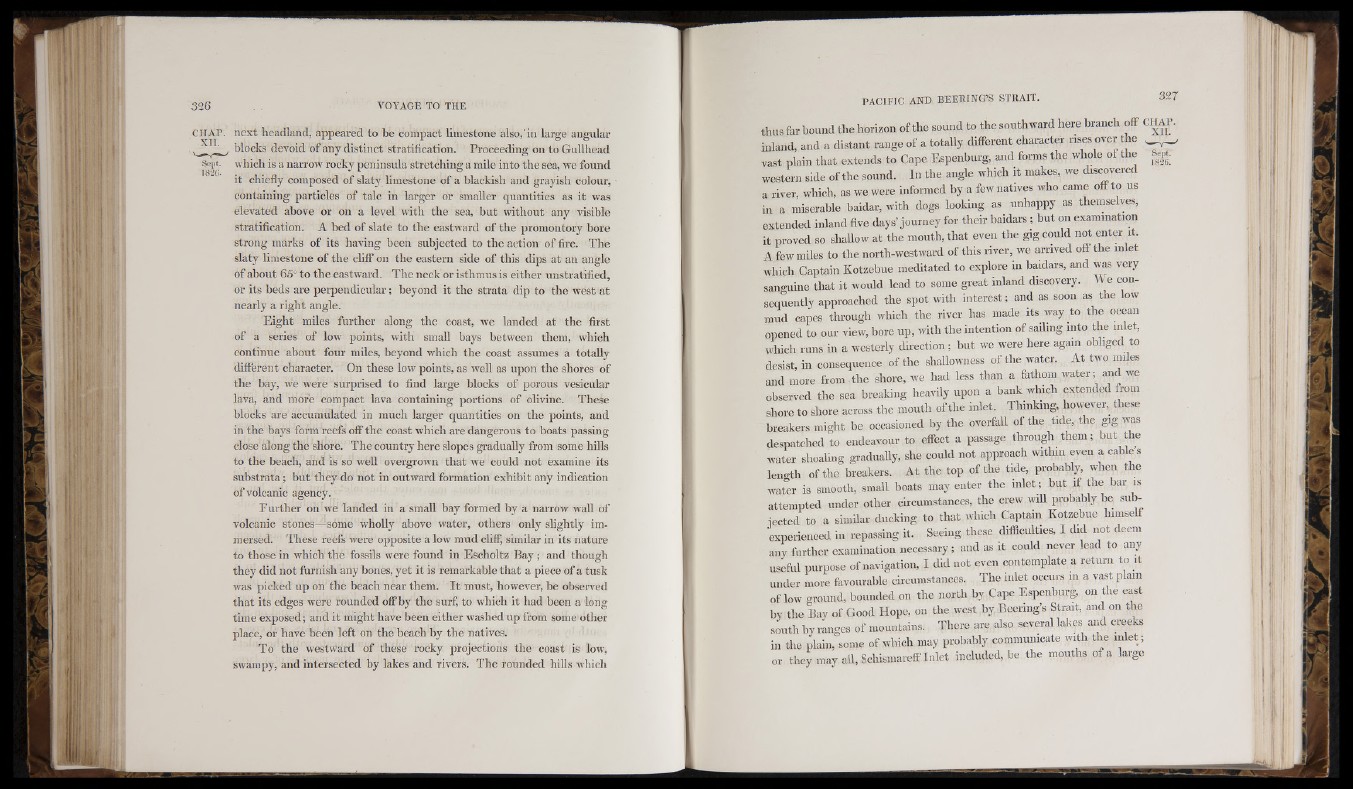
CH.AP. next headland, appeared to be compact limestone also, in large angular
7 * ! ', , blocks devoid of any distinct stratification. Froceeding on to Gullhead
Sept.
18 20.
which is a narrow rocky peninsula stretching a mile into the sea, we found
it chiefly composed of slaty limestone of a blackish and grayish colour,
containing particles of talc in larger or smaller quantities as it was
elevated above or on a level with the sea, but without any visible
stratification. A bed of slate to the eastward of the promontory bore
strong marks of its having been subjected to the action of fire. The
slaty limestone of the cliff on the eastern side of this dips at an angle
of about 65“ to the eastward. The neck or isthmus is either unstratified,
or its beds are perpendicular; beyond it the strata dip to the west at
nearly a right angle.
Eight miles further along the coast, we landed at the first
of a series of low points, with small bays between them, which
continue about four miles, beyond which the coast assumes a totally
different character. On these low points, as well as upon the shores of
the bay, we were surprised to find large blocks of porous vesicular
lava, and more compact lava containing portions of olivine. These
blocks are accumulated in much larger quantities on the points, and
in the bays form reefs off the coast which are dangerous to boats passing
close along the shore. The country here slopes gradually from some hills
to the beach, and is so w'ell overgrown that we could not examine its
substrata; but they do not in outward formation exhibit any indication
of volcanic agency.
Further on we landed in a small bay formed by a narrow wall of
volcanic stones—some wholly above water, others only slightly immersed.
These reefs were opposite a low mud cliff, similar in its nature
to those in which the fossils were found in Escholtz Bay; and though
they did not furnish any bones, yet it is remarkable that a piece of a tusk
was picked up on the beach near them. It must, however, be observed
that its edges were rounded off by the surf, to which it had been a longtime
exposed; and it might have been either -«’ashed up from some other
place, or have been left on the beach by the natives.
To the -H'estu'ard of these rocky projections the coast is low,
swampy, and intersected by lakes and rivers. The rounded hills whicli
thus far bound the horizon of the sound to the southward here branch off CHAP.
inland, and a distant range of a totally different character rises over the
vast plain that e.xtends to Cape Espenburg, and forms the whole of the Sept.
western side of the sound. In the angle which it makes, we discovered
a river, which, as we were informed by a few natives who came off to us
in a miserable baidar, with dogs looking as unhappy as themselves,
extended inland five days’journey for their baidars; but on examination
it proved so shallow at the mouth, that even the gig could not enter it.
A few miles to the north-westward of this river, we arrived off the inlet
which Captain Kotzebue meditated to explore in baidars, and was very
sanguine that it would lead to some great inland discovery. V e consequently
approached the spot with interest; and as soon as the low
mud capes through which the river has made its way to the ocean
opened to our view, bore up, with the intention of sailing into the inlet,
which runs in a westerly direction; but we were here again obhged to
desist, in consequence of the shallowness of the water. At two miles
and more from the shore, we had less than a fathom water; and we
observed the sea breaking heavily upon a bank which extended fiom
shore to shore across the mouth of the inlet. Thinking, however, these
breakers might be occasioned by the overfall of the tide, the gig was
despatched to endeavour to effect a passage through them; but the
water shoaling gradually, she could not approach within even a cables
lenrth of the breakers. At the top of the tide, probably, when the
water is smooth, small boats may enter the inlet; but if the bar is
attempted under other circumstances, the crew wiU probably be subjected
to a similar ducking to that which Captain Kotzebue himself
experienced iu repassing it. Seeing these difficulties, I did not deem
any further examination necessary ; and as it could never lead to any
useful purpose of navigation, I did not even contemplate a return to it
under more favourable circumstances. The inlet occurs iii a vast plain
of low ground, bounded on the north by Cape Espenburg, on the east
by the Bay of Good Hope, on the west by Beering's Strait, and on the
south by ranges of mountains. There are also several lakes and creeks
in the plain, some of which may probably commuiiicate with the inlet ;
or they may all, Schismareff Inlet included, be tlie mouths of a large
i r
4